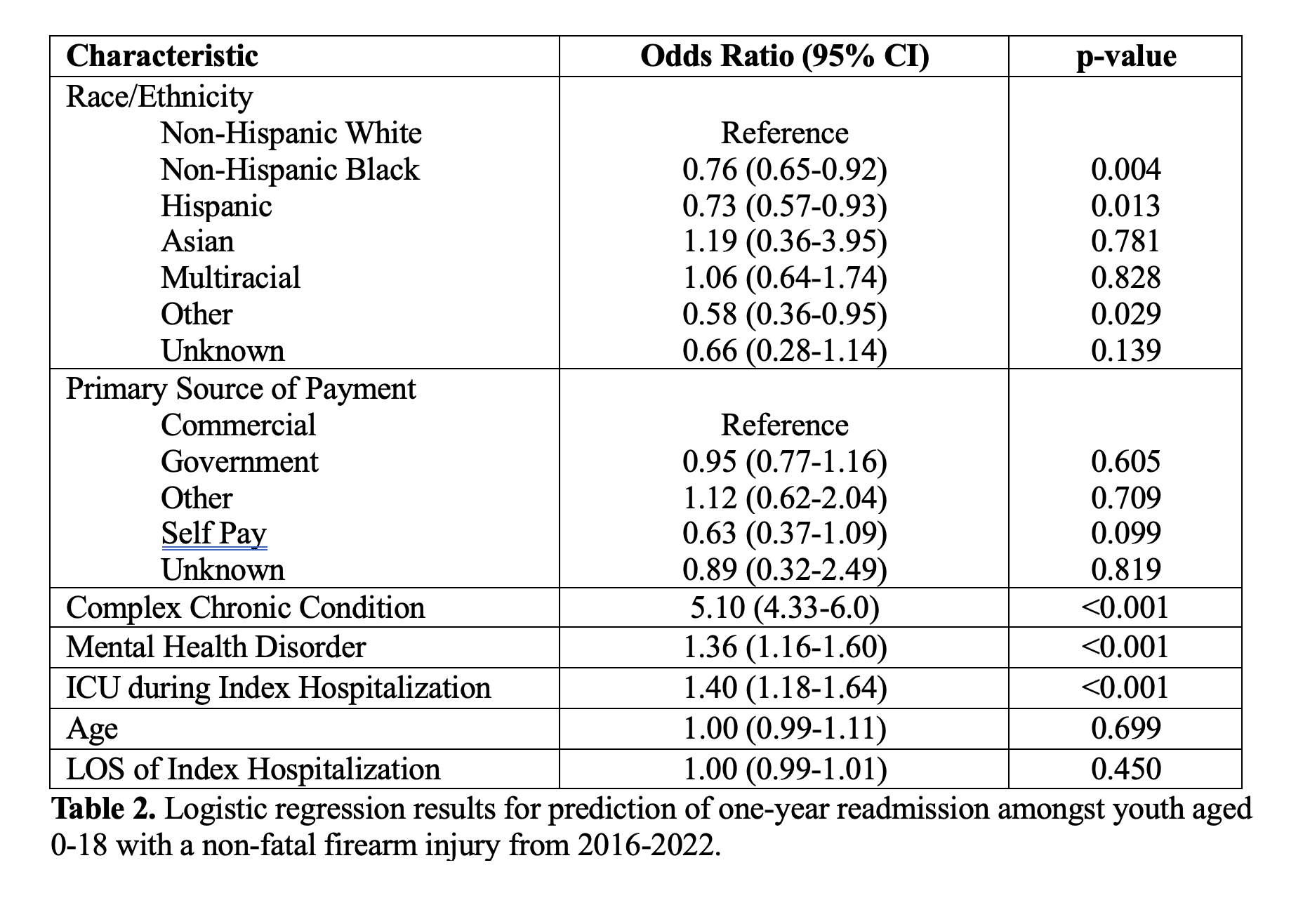Injury Prevention 2
Session: Injury Prevention 2
421 - Readmissions Among Pediatric Patients with a Non-Fatal Firearm Injury
Sunday, April 27, 2025
8:30am - 10:45am HST
Publication Number: 421.6101
Elizabeth Oddo, Medical University of South Carolina College of Medicine, Charleston, SC, United States; Mathew Gregoski, MUSC Department of Public Health Sciences, Charleston, SC, United States; Abigail L. Martin, MUSC Children's Hospital, Clemson, SC, United States; Stephanie Hayden, Medical University of South Carolina College of Medicine, Charleston, SC, United States; Annie Andrews, George Washington University School of Medicine and Health Sciences, Mt. Pleasant, SC, United States

Elizabeth Oddo, MD, MPH (she/her/hers)
Assistant Professor
Medical University of South Carolina College of Medicine
Charleston, South Carolina, United States
Presenting Author(s)
Background: Firearm injuries are a leading cause of morbidity and mortality for US youth. Non-fatal firearm injuries often lead to lasting physical and mental health consequences, but little is known about readmission rates and risk factors in this population.
Objective: To examine readmission rates and identify factors associated with readmission among pediatric patients with a non-fatal firearm injury.
Design/Methods: This retrospective cohort study was conducted using the Pediatric Health Information System (PHIS) to assess youth admitted from January 1, 2016 to December 31, 2022 with a non-fatal firearm injury. The primary outcome of interest was all-cause readmission within one year of index hospitalization. Descriptive characteristics were compared using chi-square and Mann-Whitney U tests. Variables that were significant in bivariate analysis (p < 0.05) were used as predictors in a multivariable logistic regression analysis.
Results: The cohort included 6740 youth with an index admission for a non-fatal firearm injury. 950 (14.1%) youth were readmitted within one year of their index admission. The median time to readmission was 34 days (IQR 108). The most common primary diagnoses during readmission were surgical complications, infection, and psychiatric concerns. Youth with a complex chronic condition (odds ratio [OR] 5.10, confidence interval [CI] 4.33-6.0, p< 0.001), a mental health disorder (OR 1.36, CI 1.16-1.60, p< 0.001), and an ICU stay (OR 1.40, CI 1.16-1.60, p< 0.001) had higher odds of readmission. Conversely, Non-Hispanic Black (OR 0.76, CI 0.65-0.92, p=0.004), Hispanic (OR 0.73, CI 0.57-0.93, p=0.013), and youth with a race/ethnicity of “other,” which includes Pacific Islander, Native American, and other unspecified, (OR 0.58, CI 0.26-0.95, p=0.029) had significantly lower odds of readmission.
Conclusion(s): For youth with a non-fatal firearm injury, those with a complex chronic condition, a mental health disorder, and an ICU stay during index hospitalization are more likely to be readmitted within one year. Identification of readmission risk factors during index hospitalization represents an important opportunity for intervention. Psychiatric diagnoses were among the most common reasons for readmission, suggesting adequate mental health follow-up must be a priority. Additionally, more studies are needed to explore and address identified racial disparities. Clinicians should utilize this information to direct timely interventions to improve care and prevent costly readmissions.
Table 1
.png) Demographic characteristics and readmission status of youth aged 0-18 with a nonfatal firearm injury from 2016-2022.
Demographic characteristics and readmission status of youth aged 0-18 with a nonfatal firearm injury from 2016-2022.Used chi-square for categorical variables and Mann-Whitney U for continuous variables
Other race category includes Pacific Islander, Native American, and other unspecified
Table 2
 Logistic regression results for prediction of one-year readmission amongst youth aged 0-18 with a non-fatal firearm injury from 2016-2022.
Logistic regression results for prediction of one-year readmission amongst youth aged 0-18 with a non-fatal firearm injury from 2016-2022.Table 1
.png) Demographic characteristics and readmission status of youth aged 0-18 with a nonfatal firearm injury from 2016-2022.
Demographic characteristics and readmission status of youth aged 0-18 with a nonfatal firearm injury from 2016-2022.Used chi-square for categorical variables and Mann-Whitney U for continuous variables
Other race category includes Pacific Islander, Native American, and other unspecified
Table 2
 Logistic regression results for prediction of one-year readmission amongst youth aged 0-18 with a non-fatal firearm injury from 2016-2022.
Logistic regression results for prediction of one-year readmission amongst youth aged 0-18 with a non-fatal firearm injury from 2016-2022.
